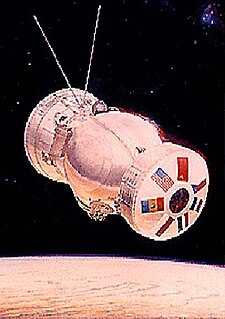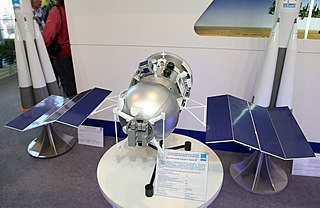Kosmos 605, or Bion 1, was a Bion satellite. Kosmos 605 was the first of eleven Bion satellites.

Kosmos 690, or Bion 2, was a Bion satellite launched by the Soviet Union.

Kosmos 782 was a Bion satellite. It carried 14 experiments prepared by seven countries in all, with participation from scientists in France, Czechoslovakia, Hungary, Poland, Romania, United States and the Soviet Union.

The Bion satellites, also named Biocosmos, is a series of Soviet biosatellites focused on space medicine. They are part of the Kosmos satellites.

Kosmos 1667, or Bion 7 was a 1985 biomedical research mission satellite involving scientists from nine countries. It was part of the Bion program. This mission was the scientific participation of nine countries.

Kosmos 936 or Bion 4 was a Bion satellite. The mission involved nine countries in a series of biomedical research experiments. The experiments were primarily follow-ups to the Bion 3 flight. Scientists from the Bulgaria, Czechoslovakia, East Germany, France, Hungary, Poland, Romania, the United States and the Soviet Union conducted experiments in physics and biology on the mission.

Bion 5, or also Kosmos 1129 was a Bion satellite. It was a biomedical research mission involving scientists from nine countries, launched on 29 September 1979, at 15:30:00 UTC. Among the experiments was the first attempt to breed mammals in space, which proved unsuccessful. The mission ended after 18.5 days, on 14 October 1979, at 02:24 UTC. The mission had the cooperation of the Bulgaria, Czechoslovakia, East Germany, France, Hungary, Poland, Romania, the United States and the Soviet Union.

Kosmos 1514 or Bion 6 was a biomedical research mission that was launched on 14 December 1983, at 07:00:00 UTC. It was part of the Bion programme.

Bion 8 or Kosmos 1887 was a Bion satellite.

Kosmos 2229, or Bion 10 was a biomedical research mission involving in ten countries plus European Space Agency (ESA). A Russian spacecraft, was launched by a Soyuz-U launch vehicle from the Plesetsk Cosmodrome. It was part of the Bion programme.

Rassvet, also known as the Mini-Research Module 1 and formerly known as the Docking Cargo Module (DCM), is a component of the International Space Station (ISS). The module's design is similar to the Mir Docking Module launched on STS-74 in 1995. Rassvet is primarily used for cargo storage and as a docking port for visiting spacecraft. It was flown to the ISS aboard Space ShuttleAtlantis on the STS-132 mission on 14 May 2010, and was connected to the ISS on 18 May 2010. The hatch connecting Rassvet with the ISS was first opened on 20 May 2010. On 28 June 2010, the Soyuz TMA-19 spacecraft performed the first docking with the module.
Kosmos 4, also known as Zenit-2 No.2 and occasionally in the West as Sputnik 14 was the first Soviet reconnaissance satellite to successfully reach orbit.
Kosmos 7, also known as Zenit-2 No.4 and occasionally in the West as Sputnik 17 was a Soviet reconnaissance satellite launched in 1962. It was the seventh satellite to be designated under the Kosmos system, and the second successful launch of a Soviet reconnaissance satellite.
Kosmos 9, also known as Zenit-2 No.7, was a Soviet reconnaissance satellite launched in 1962. It was the ninth satellite to be designated under the Kosmos system, and the third successful launch of a Soviet reconnaissance satellite, following Kosmos 4 and Kosmos 7.

Bion-M No.1 (Бион-М) was a Russian space mission, part of the Bion-M programme focused on space medicine. The new generation Bion-M continued the Soviet/Russian Bion satellite programme aimed at biological research in space. The last spacecraft of the Bion series, Bion 11, was launched in 1996. The Bion-M1 spacecraft was designed to carry biological, physiological and biotechnological experiments to low Earth orbit and return them to Earth at the end of the mission. The biological payload for Bion-M1 included rodents, amphibians, reptiles, crustaceans, mollusks, fish, insects, bacteria, plant and animal cell cultures. The spacecraft was the result of collaboration hosting biomedical payloads provided by scientific institutions from the United States, Germany, Canada, the Netherlands, Poland and other countries. The Bion-M automated spacecraft was a unique specialized space complex that aimed to determine the fundamental mechanisms of how life adapts to microgravity and then readapts to Earth-normal gravity.
Kosmos 12 or Zenit-2 No.6 was a Soviet optical film-return reconnaissance satellite launched in 1962. A Zenit-2 spacecraft, Kosmos 12 was the seventh of eighty-one such satellites to be launched.
Kosmos 13 or Zenit-2 No.9 was a Soviet optical film-return reconnaissance satellite launched in 1963. A Zenit-2 spacecraft, Kosmos 13 was the eighth of eighty-one such satellites to be launched.
Kosmos 15 or Zenit-2 No.9 was a Soviet optical film-return reconnaissance satellite which was launched in 1963. A Zenit-2 spacecraft, Kosmos 15 was the ninth of eighty-one such satellites to be launched.
Kosmos 214 or Zenit-4 No.45 was a Soviet, optical film-return reconnaissance satellite launched in 1968. A Zenit-4 satellite, Kosmos 214 was the fortieth of seventy-six such spacecraft to be launched.
Bion-M No.2 (Бион-М) is a planned Russian space mission, part of the Bion-M programme focused on space medicine. The new generation Bion-M continues the Soviet/Russian Bion satellite programme aimed at biological research in space. The most recent spacecraft of the Bion-M series, Bion-M No.1, was launched in 2013. The Bion-M spacecraft are designed to carry biological, physiological and biotechnological experiments to low Earth orbit and return them to Earth at the end of the mission.





